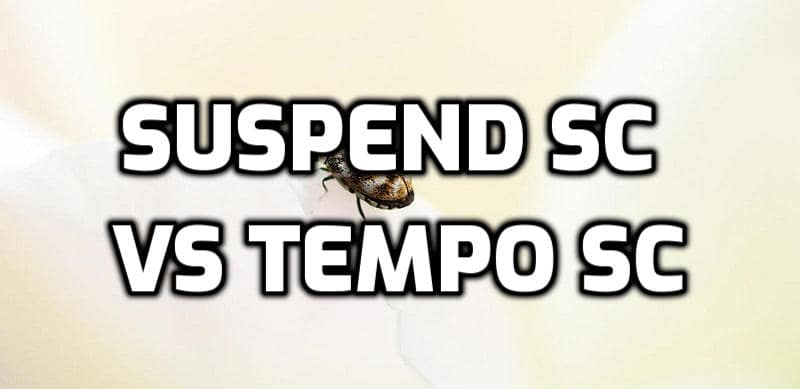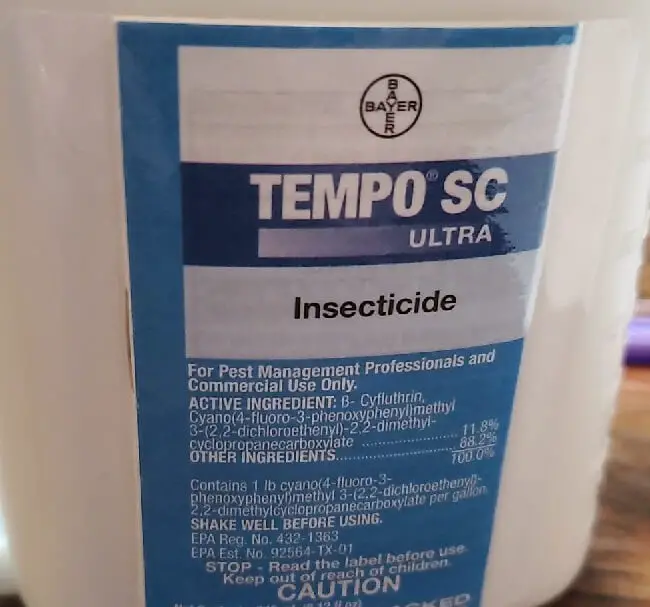Suspend SC Vs Tempo SC Insecticide

The primary distinction between Tempo SC Ultra and Suspend SC lies in the active compounds they use. Beta-Cyfluthrin is the active ingredient in Tempo SC Ultra, while Deltamethrin is the active component in Suspend SC. Although they both belong to the synthetic pyrethroids class of insecticides, they’re effective against many of the same types of insects.
Suspend SC Vs Tempo SC Table
The table below outlines each product’s primary attributes for easier comparison.
Suspend SC | Tempo SC |
 |  |
Suspend SC Insecticide uses Deltamethrin (4.75%) | Tempo SC Ultra Insecticide contains Beta-Cyfluthrin (11.8%) |
Suspend SC is a liquid insecticide concentrate | Tempo SC Ultra is a suspension concentrate of a powder formulation |
Virtually no odor or staining | No odor and less visible residu |
Suspend SC demonstrates a longer-lasting residual effect ranging from 90 to 120 days | Tempo SC Ultra has residual effectiveness lasting up to 3 months. |
Suspend SC Insecticide is mixed at a rate of 0.25 oz to 1.5 oz per gallon of water | Tempo SC Ultra Insecticide is mixed at a rate of 16 mL per 1,000 sq ft |
Kills over 50 insects including Ants, Bed Bugs, Spiders, Pantry Insects, Silverfish, Fleas, Roaches, Mosquitoes and others | Effective against the pests such as ants, carpet beetles, flies, cockroaches, crickets, millipedes, silverfish, spiders, Japanese beetles, hornets, yellow jackets, and more. |
Active Ingredient
The active ingredients in an insecticide play a key role in defining its effectiveness and target pests. Tempo SC Ultra Insecticide contains Beta-Cyfluthrin (11.8%) as its active ingredient. This synthetic pyrethroid is known for its high insecticidal properties.
On the other hand, Suspend SC Insecticide uses Deltamethrin (4.75%) as its active ingredient, a synthetic pyrethroid with a different chemical structure and activity.
Formulation
The formulation of these two insecticides differs slightly. Suspend SC is a liquid insecticide concentrate that needs to be diluted with water and applied using a sprayer. This formulation type can provide flexibility in concentration control.
Tempo SC Ultra, however, is a suspension concentrate that delivers the potency of a powder formulation in a liquid, which can offer convenience in mixing and application.

Pet Safe
Another important consideration when choosing an insecticide is whether or not it is safe to use around pets. Suspend SC is secure to use around pets as long as it is used according to the label directions.
Tempo SC is also safe to use around pets as long as it is used according to the label directions. In short, both are pet-safe after it dries.
Residual Effectiveness
Regarding residual effectiveness, Suspend SC demonstrates a longer-lasting indoor residual effect ranging from 90 to 120 days, making it highly effective for long-term insect control.
On the contrary, Tempo SC Ultra, although odorless and non-staining, has shorter residual effectiveness, lasting up to 3 months.
Target Pests
The variety of pests these insecticides can control differs significantly. Tempo SC Ultra claims to control over 100 insect pests, including ants (excluding Pharaoh and Harvester ants), carpet beetles, flies, cockroaches, crickets, millipedes, pillbugs, silverfish, spiders, Japanese beetles, hornets, yellow jackets, and more.
Suspend SC targets a lesser number of insects, approximately 50, but still includes common pests like ants, spiders, roaches, flies, mosquitoes, fleas, wasps and hornets, centipedes, millipedes, pantry pests, silverfish, bedbugs, beetles, and more.

Dosage & Yield
Dosage and yield also vary between these two products. Tempo SC Ultra Insecticide is mixed at a rate of 16 mL per 1,000 sq ft, and one 40 mL bottle makes about 30 gallons of spray.
Meanwhile, Suspend SC Insecticide is mixed at a rate of 0.25 oz to 1.5 oz per gallon of water, and one 16 oz bottle can yield up to 64 gallons of mix.
Packaging
Tempo SC Ultra comes in a 240 mL tip-and-pour plastic bottle, making it easy to measure and pour. Suspend SC, however, is packaged in a 16 oz bottle.
Usage Areas
Both products find their applications in a wide range of settings, including residential, industrial, and institutional areas. Nonetheless, Suspend SC specifically mentions being suitable for specific environments such as aircraft (cargo only), granaries & grain mills, and wineries, broadening its use scenarios.
For Use In
Both Tempo SC Ultra and Suspend SC serve as excellent general-purpose perimeter pesticides for indoor and outdoor use. This means they can be effectively used in a variety of environments to control insect infestations.
How To Use
Both Suspend SC and Tempo SC insecticides must mix with water before they can be applied. Then you can apply them with a pump-up sprayer, backpack sprayer, or hose-end Sprayer where you want to get rid of insects.
You can also be applied as a spot treatment to specific areas where you see insects or insect activity. You can also apply it as a crack and crevice treatment to get into small spaces where insects may hide.
Both products should be applied until the area is wet, but not to the point of runoff. After application, you should allow the area to dry completely before allowing people or pets to enter the treated area. Reapply as needed to maintain control of insects.
Our Observation
From our comparison, it’s clear that both Tempo SC Ultra and Suspend SC have their unique strengths. Tempo SC Ultra’s wide range of target pests and convenient packaging could make it a more appealing choice for households or institutions dealing with a variety of insect issues.
However, the extended residual effectiveness and broader usage areas of Suspend SC may make it a superior option for long-term control and specific settings such as aircraft and granaries.
In conclusion, the choice between Tempo SC Ultra and Suspend SC largely depends on the specific requirements of your insect control project. Considering the target pests, desired residual effectiveness, usage area, and ease of application can help make the best choice between these two effective insecticides.

James E. Butkovich, Pest control maven with a knack for eco-friendly & Chemical solutions. Blogger with a mission to make homes pest-free, one post at a time.